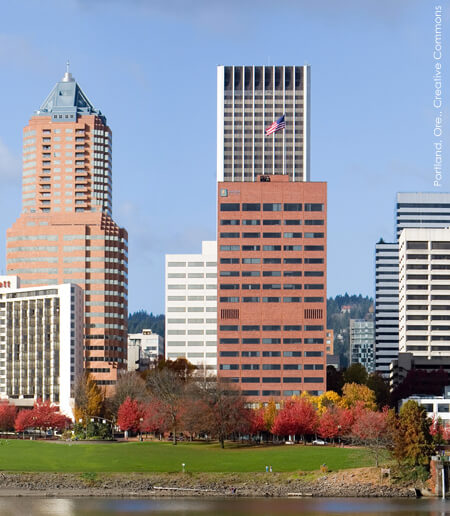Portland, Oregon Adopts Bird-Friendly Building Philosophies
 |
(Washington, DC, October 15, 2013) The Portland, Ore., City Council has adopted a resolution that embraces a variety of bird-friendly components, adding the city to a growing list of communities that have either already adopted or are actively considering bird-friendly approaches to local building designs.
The resolution was passed on Wed., Oct. 2, and was introduced by Portland Commissioner Dan Saltzman. Key contributors to the effort were the Audubon Society of Portland and American Bird Conservancy (ABC).
“This is a great example of a city adopting a progressive philosophy of urban design that embraces bird-friendly concepts. We are seeing a growing awareness of and alarm about the very significant bird mortality that is occurring across the United States as a result of bird collisions with buildings,” said Dr. Christine Sheppard, Bird Collisions Campaign Manager at American Bird Conservancy. “Studies suggest that as many as one billion birds die from such collisions each year in the U.S. alone. As ABC and other groups have raised awareness of the problem, we are seeing increasing interest among local governments, architects, and developers regarding bird-friendly building design and how to foster it through mandatory and voluntary regulatory processes.”
ABC supported Portland Audubon from the beginning, working closely with Mary Coolidge, then Assistant Conservation Director. ABC's Bird-Friendly Building Design—the only national publication on the issue—served as the basis for a local version designed by Portland Audubon.
In 2003, Portland was the fifth city selected for the U.S. Fish and Wildlife Service's Urban Conservation Treaty for Migratory Birds Program, created in 1999 to help municipal governments conserve birds in their cities. ABC joined 20 local organizations partnering to help Portland develop a comprehensive Portland Bird Agenda.
Portland's resolution is the latest in a list of local or state governments to require bird-friendly building design, which includes the state of Minnesota and the city of Oakland, Calif. Oakland has adopted requirements similar to those established in neighboring San Francisco in 2011, while Minnesota followed LEED's (Leadership in Engineering and Environmental Design) “Reducing Bird Collisions” program. In Illinois, several jurisdictions—Cook County, Highland Park, Lake County, and Evansville—have existing or pending guidelines, while national legislation has been proposed in the U.S. Congress requiring bird-friendly considerations in federal buildings.
Dr. Sheppard worked extensively with officials in San Francisco, along with Noreen Weeden from Golden Gate Audubon, to develop the city's bird-friendly requirements. Sheppard continues to present continuing education classes on the issue to architecture firms across the country upon request and is the author of ABC's Bird-Friendly Building Design.
Specific measures detailed in the Portland resolution include:
- The city will seek opportunities to incorporate bird-friendly building design and practices into city facilities;
- The draft Comprehensive Plan (land use plan for the city of Portland) shall include goals and policies that promote habitat and bird-friendly design and building management practices;
- The draft Central City 2035 Plan that guides development in the Central part of the city for the next 20+ years shall include an action item to explore development standards, design guidelines, and educational and incentive programs to improve bird safety in the Central City;
- Development of the City's Green Building Policy will recognize the benefits of bird-friendly building design and building management practices and will explore opportunities to advance bird-friendly design, including but not limited to referencing the Resource Guide to Bird-Friendly Building Design and bird-friendly design guidelines;
- The City shall explore opportunities to advance bird-friendly design and management practices through other future planning efforts as applicable; and
- The City will work with partners to promote awareness of bird-friendly design and management practices across the city in residential and commercial properties.
The resolution also recognized that Portland is home to over 209 species of birds; that about one in four bird species in the U.S. is experiencing population declines; that Portland sits on the Pacific Flyway, a major north-south flight route extending from Alaska to South America; and that collisions with buildings and other manmade structures are a primary threat to migratory birds.


















































